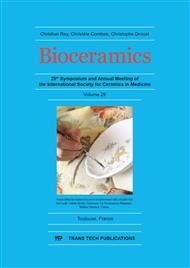p.210
p.217
p.223
p.228
p.234
p.239
p.245
p.250
p.255
Cementing Technique for THA Sockets Using Bone Cement and HA Granules: Modified-IBBC
Abstract:
In this report, the middle-term clinical and radiographic results were investigated in total hip arthroplasty (THA) cases using PMMA bone cement and hydroxyapatite (HA) granules (modified interfacial bioactive bone cement technique; M-IBBC). 76 hip joins (69 cases) were operated between June 2010 and September 2012, and followed. The minimum follow-up period was 4.5 years, the average follow-up was 5.5 years and average age at operation was 67.4 years. Revision was not performed. Average Japanese orthopaedic association (JOA) score improved from 45 to 88. Socket loosening was not observed radiographically. X-p findings of sockets demonstrated radiolucent line in the outer part of Zone 1 (designated Zone 1a in this report) in 1.3% immediately after the operation, and 6.6% at 1 year postoperatively. After 2 years progressive changes were not observed. The improvement of radiolucent line was observed in two cases at 3 years postoperatively and radiolucent line in Zone 1a was observed in 3.9%. These findings suggested that osteoconductivity of HA granules was maintained after the operation.
Info:
Periodical:
Pages:
234-238
Citation:
Online since:
November 2017
Price:
Сopyright:
© 2017 Trans Tech Publications Ltd. All Rights Reserved
Share:
Citation:


